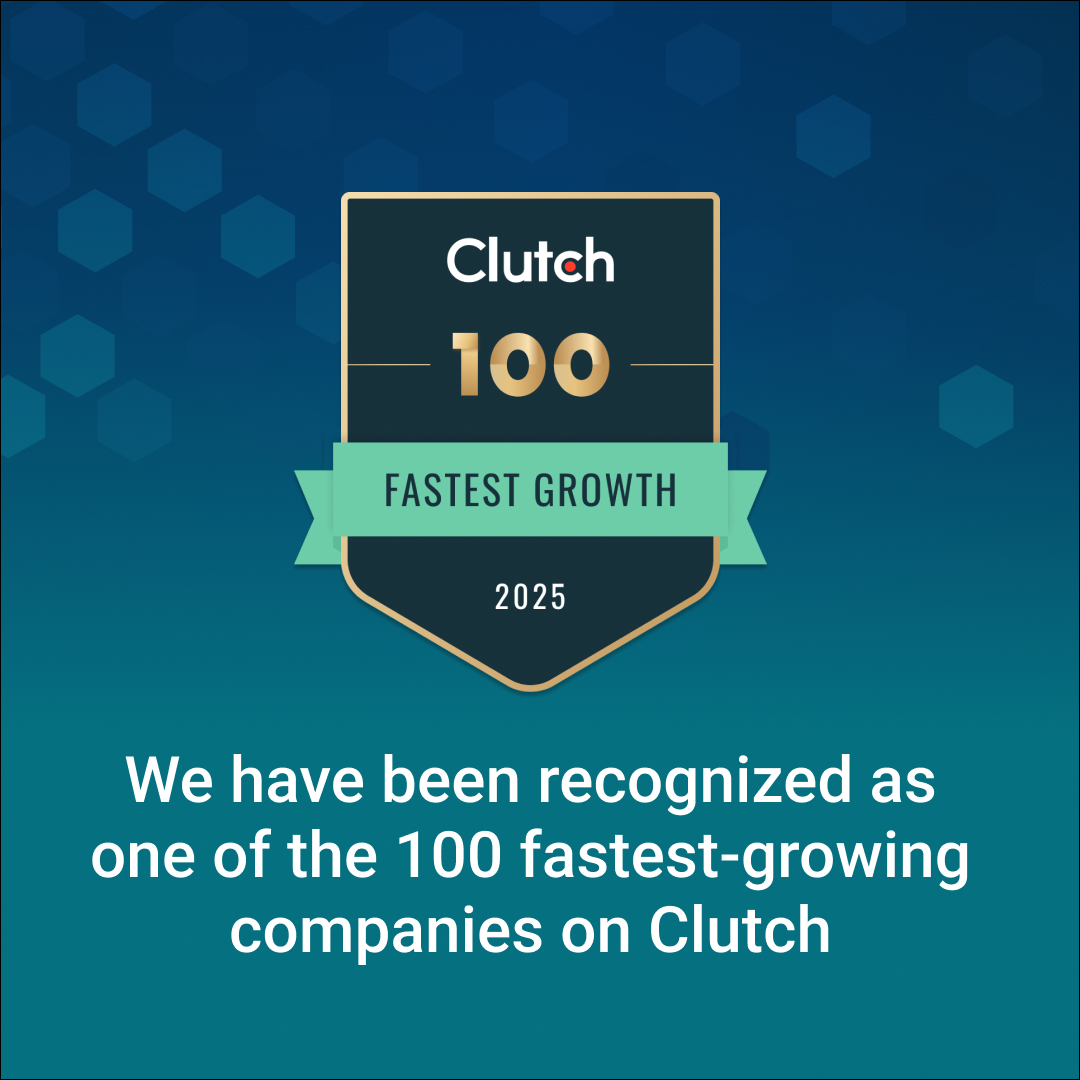Introduction
Operational leaders today face mounting complexity—from volatile demand cycles and supply chain disruptions to rising labor costs and the need for real‑time decision-making. AI is stepping in as a pivotal tool, offering data‑driven automation, predictive insight, and agile responsiveness. This comprehensive guide explores how AI is transforming operations by optimizing processes, minimizing waste, and empowering smarter strategic choices.
What is AI and Why Does It Matter in Pharma?
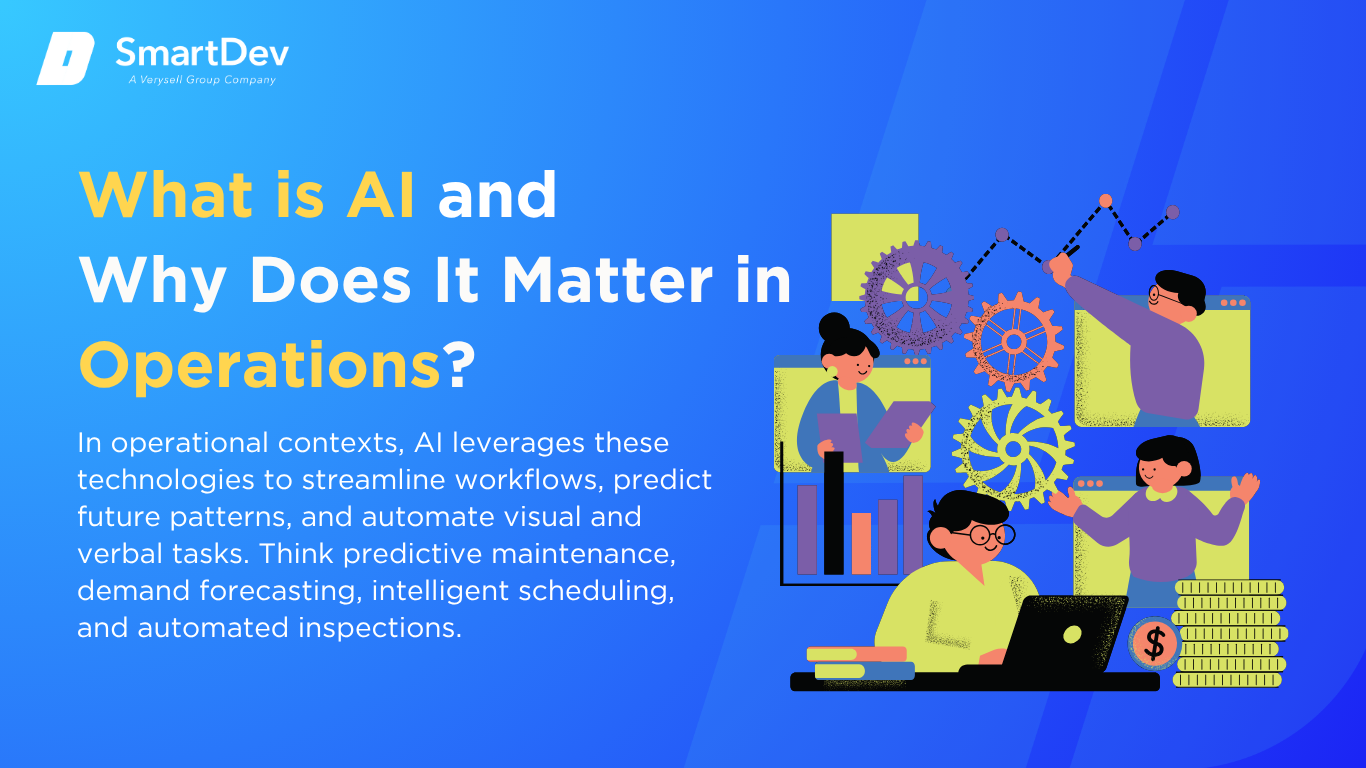
-
Definition of AI and Its Core Technologies
Artificial Intelligence (AI) refers to computer systems designed to perform tasks that typically require human intelligence, learning, reasoning, sensing, and decision-making. According to IBM, this includes core technologies like machine learning (ML), natural language processing (NLP), and computer vision. In operational contexts, AI leverages these technologies to streamline workflows, predict future patterns, and automate visual and verbal tasks. Think predictive maintenance, demand forecasting, intelligent scheduling, and automated inspections.
-
The Growing Role of AI in Transforming Operations
AI is increasingly embedded in operational frameworks, fundamentally enhancing efficiency and adaptability. Through machine learning, systems can analyze historical and real-time data, such as equipment performance or shipment timelines, to predict failures or delays before they occur. This shift enables proactive maintenance and streamlined logistics.
Computer vision AI now powers automated quality control on production lines, using image analysis to detect defects faster than human eyes. NLP tools process operator reports, maintenance logs, and supplier communications, extracting actionable insights without manual review.
Furthermore, AI-driven robotic process automation (RPA) is stepping in for repetitive tasks: inventory data entry, invoice reconciliation, and scheduling, liberating human staff for high-level problem-solving. Together, these AI applications foster agility, precision, and cost-efficiency across operations.
-
Key Statistics or Trends in AI Adoption
- AI investment in operations is accelerating. According to McKinsey’s 2024 Global AI Adoption report, 44% of manufacturing and supply chain leaders are piloting or deploying AI, with a projected ROI of 20–30% within two years.
- Deloitte’s 2023 industry survey found that 60% of logistics firms implementing predictive analytics through AI have reduced lead-time variability by up to 25%.
- Global market forecasts estimate the AI in the supply chain & logistics sector will grow from $2.9 billion in 2023 to $15.3 billion by 2030, with a CAGR of 27%, driven largely by demand forecasting and warehouse automation technologies.
Business Benefits of AI in Operations
AI delivers measurable operational value by addressing core pain points: inefficiency, high operational cost, process delays, and quality variability. Below are five key benefits driving business value today.
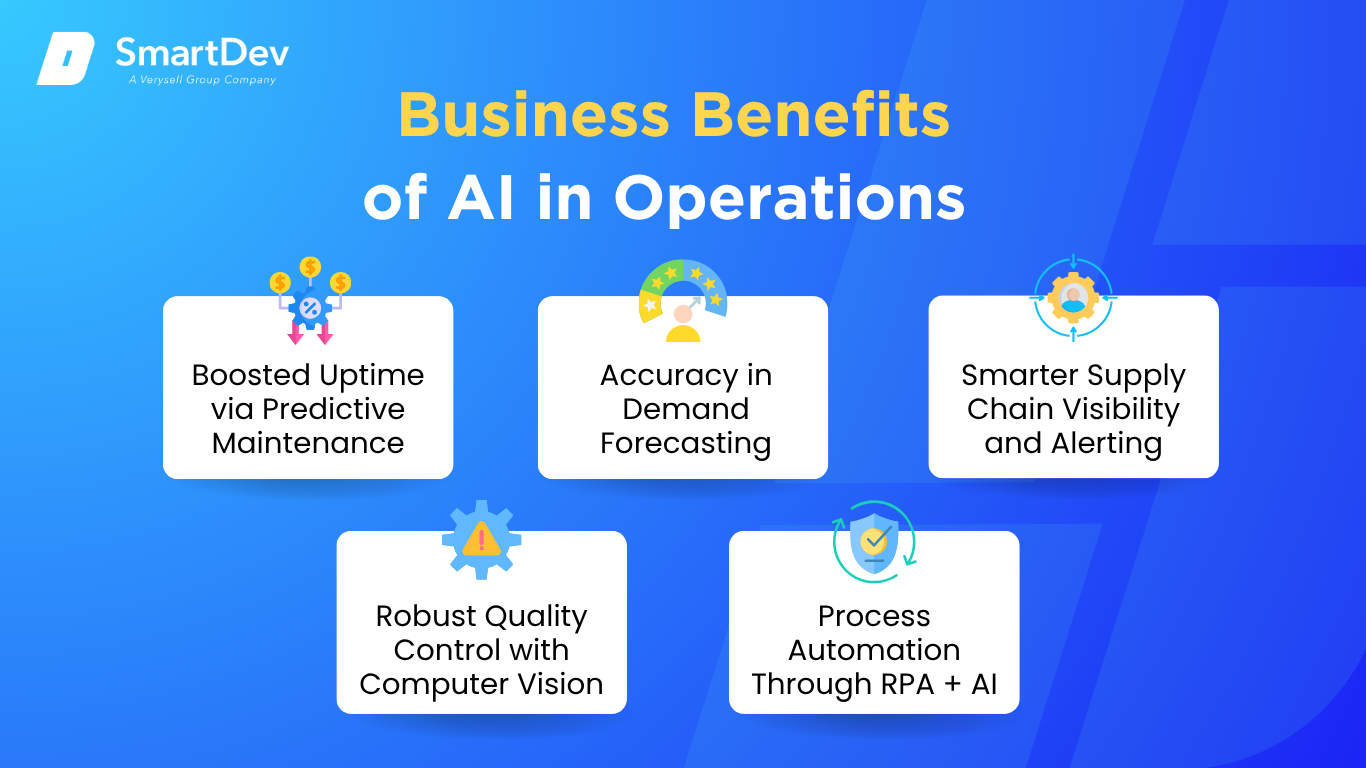
1. Boosted Uptime via Predictive Maintenance
AI models analyze real-time sensor data from machines to predict equipment failures before they occur. By identifying early warning signs such as temperature spikes, vibration anomalies, or power fluctuations, predictive maintenance schedules can be dynamically adjusted to avoid costly breakdowns.
This data-driven approach shifts maintenance from reactive to proactive, cutting unplanned downtime by 20–40% and extending equipment lifespan. For heavy industries like oil and gas or manufacturing, this can translate into millions in avoided losses and improved asset utilization.
2. Enhanced Accuracy in Demand Forecasting
Machine learning algorithms digest complex patterns across sales history, seasonality, promotions, weather, and market trends to refine demand forecasts. This is especially valuable in sectors with fluctuating demand like retail, automotive, or consumer goods.
Accurate forecasting reduces stockouts and overstocks, optimizes warehouse space, and ensures smoother supply chain planning. Organizations can shift from reactive replenishment to strategic inventory management, improving service levels while cutting carrying costs.
3. Smarter Supply Chain Visibility and Alerting
AI-driven platforms integrate structured and unstructured data sources—from GPS sensors, ERP systems, supplier emails, to weather forecasts—to deliver a unified supply chain control tower.
When anomalies like port delays, supplier non-compliance, or route disruptions occur, AI detects them early and proposes mitigation steps, such as rerouting, alternate sourcing, or inventory rebalancing. This proactive approach minimizes delays and maintains customer satisfaction.
4. Robust Quality Control with Computer Vision
AI-powered visual inspection systems scan products in real-time during manufacturing, identifying surface defects, assembly errors, or material inconsistencies with high precision.
This reduces human error, speeds up inspection, and ensures consistent quality. In sectors like electronics, automotive, or food processing, where defect tolerance is low, AI enhances product reliability while lowering costs tied to scrap, rework, or warranty claims.
5. Process Automation Through RPA + AI
Robotic Process Automation (RPA) enhanced with AI enables automation of tasks involving semi-structured data such as purchase orders, invoices, and shipping manifests. These systems extract and validate data using NLP and ML, reducing manual data entry errors and transaction cycle times. Businesses benefit from faster processing, improved accuracy, and reallocation of human resources to higher-value tasks like vendor negotiations or logistics planning.
Challenges Facing AI Adoption in Operations
While AI promises strong upsides, real-world implementation comes with critical hurdles.
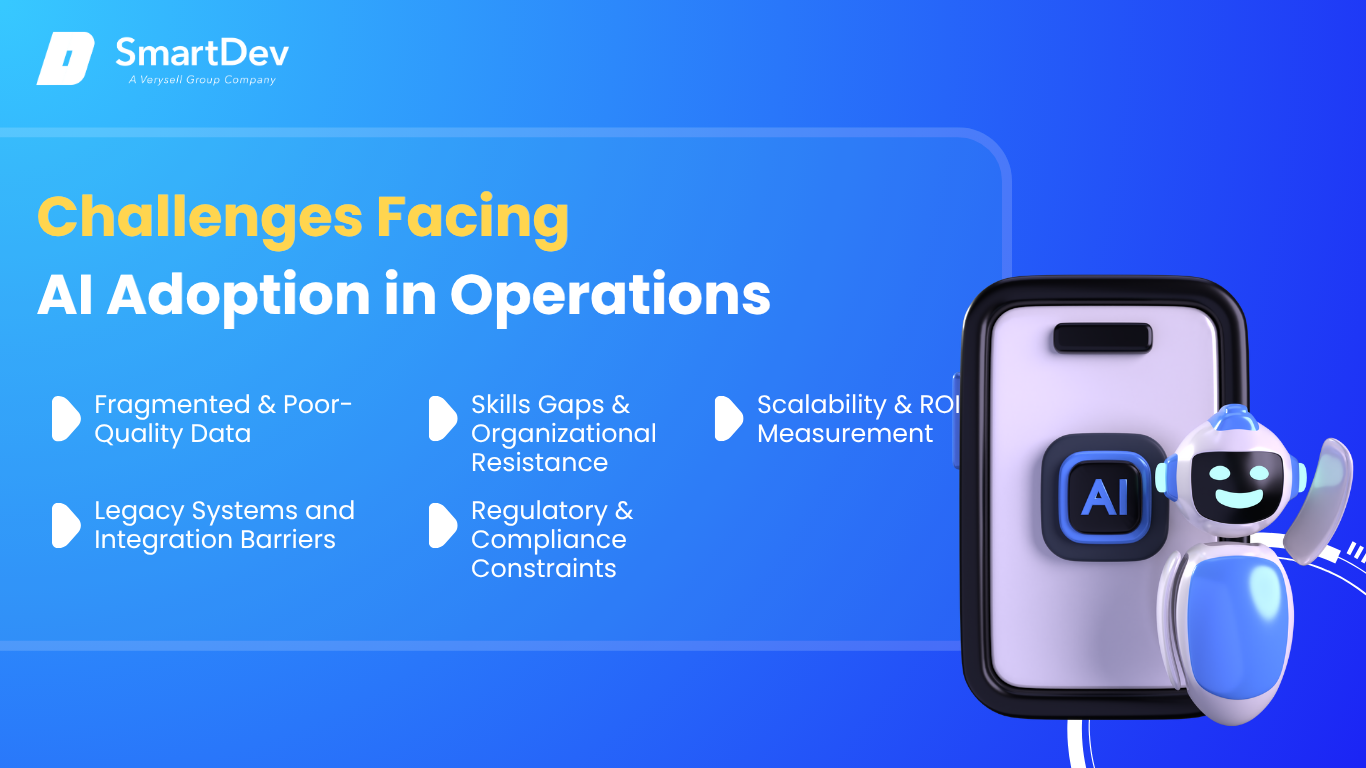
1. Fragmented & Poor-Quality Data
Operational data is often siloed across legacy systems, spreadsheets, and manual logs, with inconsistent formats or missing fields. This lack of harmonization makes AI training and inference unreliable.
Cleaning, centralizing, and maintaining high-quality data requires investment in data pipelines, data stewards, and ongoing governance—a hurdle many companies underestimate during early AI projects.
2. Legacy Systems and Integration Barriers
Many production and logistics environments operate on outdated systems not designed for real-time analytics or AI integration. Systems like SCADA or legacy ERP lack the API compatibility required for modern AI platforms. Bridging this gap demands middleware solutions, edge computing, or full-scale digital transformation efforts, all of which come with cost, complexity, and cybersecurity implications.
Before investing in AI systems in your pharma institution, the awareness of ethical problems is important, you can read more at AI Ethics Concerns: A Business-Oriented Guide to Responsible AI
3. Skills Gaps & Organizational Resistance
AI tools are only as useful as the teams using them. However, frontline workers and mid-level managers often lack training in interpreting AI insights or trusting algorithmic recommendations. Moreover, fear of job displacement can create resistance, especially in unionized or change-averse environments. Investing in upskilling, clear communication, and hybrid human-AI workflows is critical for adoption.
4. Regulatory & Compliance Constraints
Industries like pharmaceuticals, aerospace, and food manufacturing face stringent regulatory frameworks requiring traceability, validation, and auditability of every operational decision. AI systems, especially black-box models, can struggle to meet these standards without explainability tools, model governance frameworks, and human oversight layers—all of which can slow down implementation.
5. Scalability & ROI Measurement
Piloting an AI solution in a single factory or process is relatively simple; scaling it across an enterprise is another matter. Organizations often struggle to replicate success due to varying infrastructure, inconsistent data quality, and lack of standardized deployment frameworks. In addition, measuring long-term ROI—especially for intangible gains like agility or early risk detection—requires clear KPIs and robust tracking mechanisms.
Specific Applications of AI in the Operations

1. Predictive Maintenance
AI in predictive maintenance uses sensor data and ML algorithms to forecast equipment failures before they occur, addressing the costly issue of unplanned downtime. It leverages time-series data and anomaly detection models integrated into IoT dashboards, triggering alerts when patterns deviate. This proactive insight improves equipment uptime, reduces repair costs, and extends asset life while requiring robust data pipelines and quality sensor inputs.
Real-world example: GE, Uber, UPS (Fleet Maintenance) use mixed AI & IoT for fleet upkeep, cutting maintenance delays and keeping vehicles operational with predictive alerts and optimized scheduling.
2. Demand Forecasting & Inventory Optimization
AI-driven demand forecasting analyzes historical sales, seasonality, promotions, and external factors like weather or events to predict future needs. It employs ML regression and time-series models, feeding enterprise systems (like ERP/WMS) to automate replenishment and reorder points. Businesses benefit from reduced stockouts and overstock—boosting service levels and cutting inventory carrying costs.
Real-world example: Church Brothers Farms (Produce) used ThroughPut AI to increase short-term forecasting accuracy by up to 40%, reduce excess inventory, and better align planting and shipment schedules.
3. Route Optimization & Logistics Efficiency
AI optimizes transportation by analyzing real-time traffic, delivery windows, fuel prices, and load capacities using routing heuristics and reinforcement learning. It integrates with GPS and TMS systems, dynamically updating driver routes and schedules for maximum efficiency. This reduces fuel consumption, delivery delays, and CO₂ emissions, meaning greener and faster logistics—but demands real-time data connectivity and system integration.
Real-world example: UPS’s On-Road Integrated Optimization and Navigation (ORION) platform leverages AI and advanced algorithms to optimize driver routes daily. The system analyzes up to 250 million address points, weather data, traffic patterns, and package volume to determine the most efficient delivery sequence. Since implementation, UPS has saved millions of gallons of fuel annually, reduced CO2 emissions significantly, and increased on-time delivery performance by more than 90%. These benefits underscore the environmental and operational advantages of AI in logistics.
4. Robotic Process Automation (RPA) for Admin Tasks
RPA bots automate repetitive workflows like invoice processing, purchase orders, and data entry in operational systems like ERP and CRM. These bots use rule-based AI or light ML (NLP) to interpret invoices and automate routine tasks. The result: reduced manual hours, fewer errors, and faster cycle times—though governance around bot logic and change control is critical.
Real-world example: Triumph Business Capital partnered with Xerox to implement RPA for financial document handling. By automating billing and document verification processes, they achieved a 95% reduction in processing time and reallocated human resources to higher-value tasks.
5. Robotic & Autonomous Material Handling
Warehouse robots equipped with navigation AI handle product picking, stacking, and transporting, integrating with WMS systems. Using computer vision and RL, these robots collaborate with humans and optimize pathways dynamically. This streamlines throughput, reduces labor strain, and enhances fulfillment speed—yet requires safety frameworks and infrastructure upgrades.
Real-world example: Amazon’s integration of over 750,000 mobile robots in its fulfillment centers has revolutionized warehouse operations. These robots, guided by AI and sensor-based navigation, retrieve products, transport goods, and optimize space allocation in real-time.
6. Supplier Risk Management & Procurement Optimization
AI analyzes supplier data—delivery times, quality scores, geo-risk—to score vendors and predict disruptions using ML risk analysis. It integrates into procurement platforms (like SAP Ariba) to dynamically recommend sourcing and contract parameters. This enhances supply chain resilience, lowers risk, and improves negotiation power, provided data privacy and fairness in vendor scoring are managed.
Real-world example: Jaguar Land Rover implemented AI-based supplier risk analytics to gain early warnings of supply chain disruptions. During the COVID-19 pandemic, the AI system identified potential issues in Mexican supplier operations weeks before traditional methods could detect them.
Whether you’re a COO looking to optimize logistics or a CTO aiming to digitize supply chains, the future of operational excellence starts with smart AI adoption. Explore custom AI solutions in predictive maintenance, robotic process automation, and logistics optimization at AI Solution Delivery. Talk to an AI expert at SmartDev to start automating your operations today.
Examples of AI in Operations
AI enhances operations across companies. Below are real-world cases demonstrating measurable impact and innovation.
Real‑World Case Studies
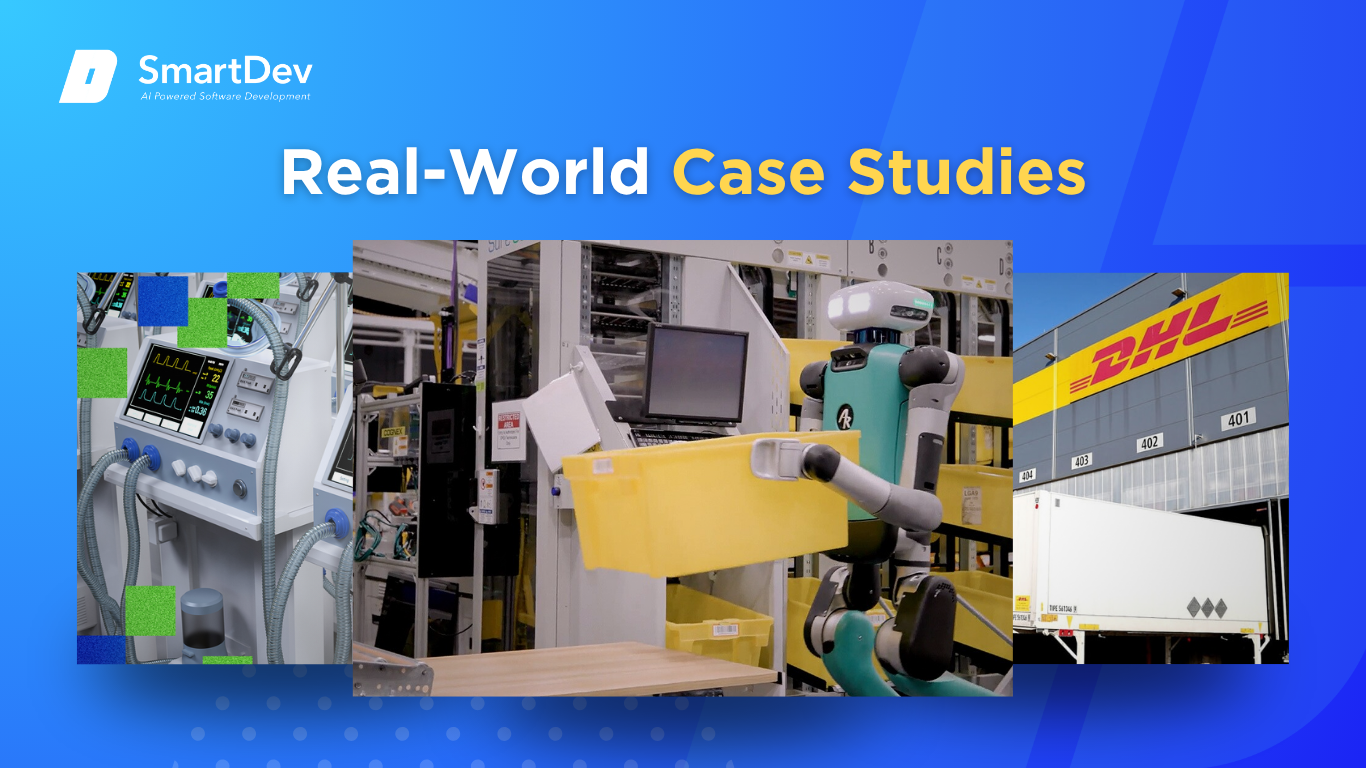
1. Amazon: Transforming Fulfillment Operations with AI
Amazon has long been a trailblazer in logistics innovation, and its use of AI in operations further strengthens this position. The company has introduced intelligent automation across its global fulfillment centers to streamline operations, increase speed, and reduce labor dependence.
With millions of orders processed daily, Amazon faced increasing pressure to manage scale while maintaining delivery speed and cost efficiency. The human labor required to fulfill this scale posed limitations in terms of cost, speed, and reliability.
Amazon implemented a fleet of over 750,000 mobile robots and AI-driven robotic arms to automate critical material handling tasks, such as item retrieval, sorting, and packaging. Machine learning models control robot movement and predict optimal inventory placement. Real-time sensor data enables dynamic adjustments in warehouse routing and item sorting.
The result was a 25 percent reduction in fulfillment costs and faster order processing. Amazon improved warehouse throughput without proportionally increasing headcount, scaling efficiently during peak demand.
Amazon’s adoption of AI for warehouse operations demonstrates how large-scale businesses can enhance agility, reduce costs, and improve service quality through intelligent automation.
2. Mayo Clinic and Cleveland Clinic: AI for Medical Inventory Optimization
These leading hospitals leveraged AI to gain visibility and control over their medical inventory, aiming to reduce waste and improve patient care. Hospitals frequently face stockouts and overstocking of critical medical supplies, leading to high waste and financial inefficiencies.
They implemented AI-driven inventory management platforms that monitor real-time consumption, predict demand, and suggest optimal reorder levels. Machine learning algorithms analyze usage trends and supplier reliability to forecast inventory needs and automate restocking workflows.
Mayo Clinic reduced inventory waste by 25 percent, while Cleveland Clinic enhanced forecasting accuracy and minimized supply shortages. The use of AI in hospital inventory systems significantly improves operational efficiency, resource planning, and patient service levels.
3. DHL: Enhancing Delivery Performance through Route Optimization
DHL, a global logistics leader, uses AI to optimize delivery routing and fleet operations across its vast logistics network. Growing customer demands for faster, on-time deliveries and sustainability goals compelled DHL to seek smarter route planning methods.
DHL integrated AI into its transport management systems to provide dynamic route recommendations based on live conditions. AI models consider weather, traffic, customer preferences, and package characteristics to determine optimal delivery paths.
The company achieved a 12 percent reduction in transportation costs and an 18 percent increase in on-time deliveries. DHL’s investment in AI-enabled logistics highlights how smart route optimization contributes to cost savings, customer satisfaction, and environmental benefits.
Read our detail project at An Advanced AI-integrated Speaking Application: Mastering the art of communication | SmartDev
Innovative AI Solutions
Emerging artificial intelligence applications continue to reshape decision-making and operational processes within the pharmaceutical industry. The following innovations illustrate next-generation capabilities and evolving opportunities.
The landscape of AI in operations is rapidly evolving, with organizations exploring new frontiers in digital transformation. Emerging technologies are enabling smarter decisions, greater visibility, and more agile execution across supply chains and internal workflows.
Businesses face growing complexity in global supply chains, increasing demand variability, and rising pressure to improve responsiveness while reducing costs. Traditional tools often fall short in providing the agility and foresight needed in today’s fast-paced environment.
Next-generation AI solutions such as generative AI modeling, digital twins, and AI for sustainability management are redefining operational strategies.
How AI Was Applied:
- Generative AI Scenario Modeling: Companies like Kinaxis and IBM deploy generative AI to simulate complex supply chain disruptions, test multiple outcomes, and optimize response strategies.
- Digital Twins: These AI-enabled virtual models mirror physical operations, helping firms proactively identify inefficiencies, predict maintenance needs, and simulate process changes.
- Sustainability AI Platforms: Tools developed by PwC and Microsoft analyze supplier data, emissions patterns, and compliance metrics, guiding ESG strategies and reporting.
Organizations report measurable ROI including improved supply chain resilience, reduced carbon footprint, and faster decision-making cycles. One study found AI-enhanced supply chains achieve up to 3.7 times greater operational efficiency compared to traditional methods.
As AI technologies become more sophisticated and accessible, they offer a compelling opportunity for businesses to future-proof their operations. The integration of emerging AI tools will be essential for organizations aiming to lead in agility, compliance, and sustainability.
To explore more the effective of AI adoption, you can find information about Our projects and solutions we’ve developed in collaboration with our valued clients.
AI‑Driven Innovations Transforming Operations
1. Emerging Technologies in AI for Operations
Generative AI technologies are significantly transforming operational tasks by automating content creation, optimizing workflows, and enhancing strategic decision-making. Companies like IBM leverage generative AI to streamline IT operations, reducing system downtime by rapidly identifying and addressing issues. This approach has allowed businesses to reduce operational disruptions by up to 30%, demonstrating substantial ROI through improved efficiency.
Computer vision is also transforming operations by providing visual data analytics for monitoring equipment conditions, safety compliance, and inventory management. For example, Amazon employs AI-powered cameras to maintain inventory accuracy, reducing manual inspection tasks and significantly improving warehouse operational efficiency.
2. AI’s Role in Sustainability Efforts
AI plays a critical role in sustainability by using predictive analytics to significantly reduce waste and enhance energy efficiency. For instance, predictive maintenance powered by AI helps manufacturing industries reduce waste by proactively identifying machinery that needs repairs, thus avoiding production halts and resource wastage. Companies like Siemens have reported reductions in maintenance costs by up to 20% through AI-driven predictive analytics.
Energy management is another area where AI contributes significantly. AI-driven smart systems can optimize energy consumption by dynamically adjusting power usage based on predictive analytics. Microsoft data centers use AI to adjust cooling systems, resulting in up to 15% savings in energy usage, dramatically improving their environmental impact.
How to Implement AI in Operations
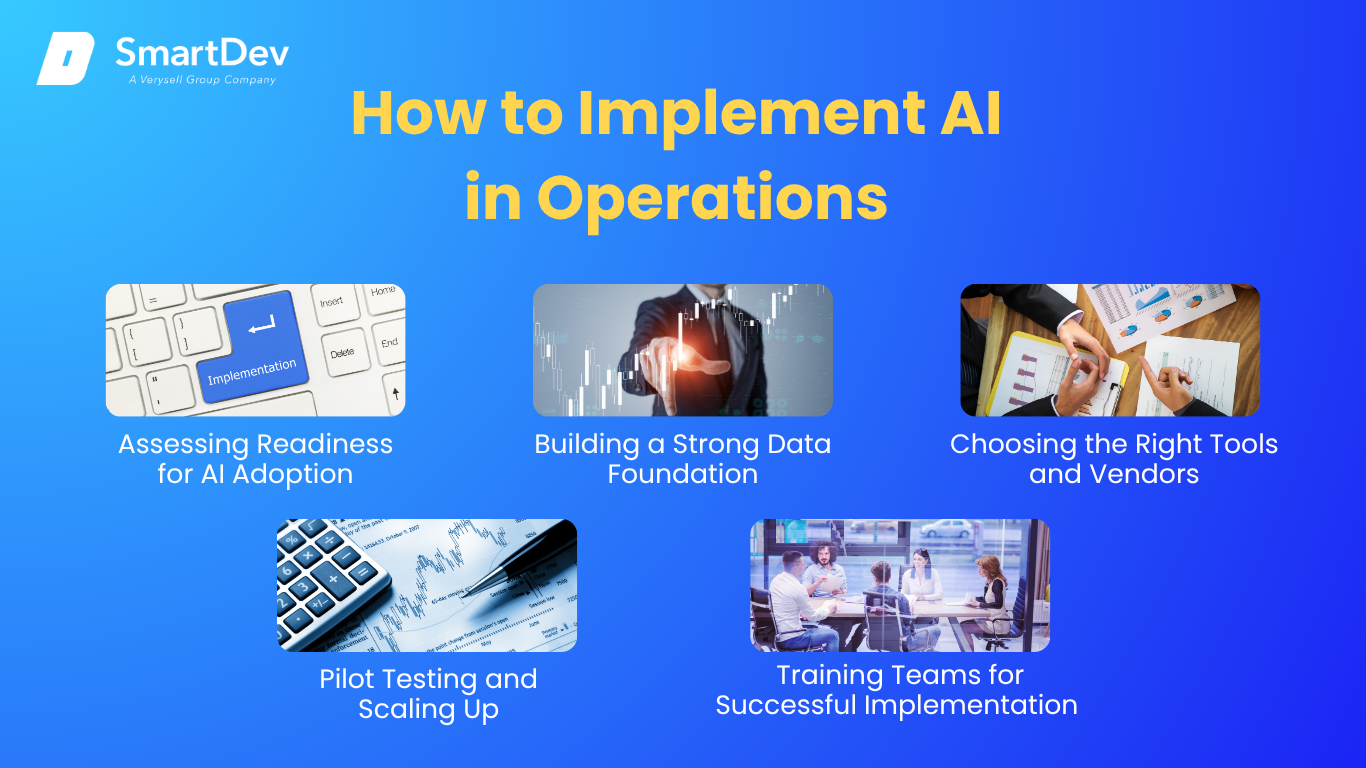
1. Assessing Readiness for AI Adoption
To effectively implement AI, start by identifying operational areas that can significantly benefit from automation and intelligent analytics. Focus on repetitive, high-volume tasks prone to human error, such as inventory management, predictive maintenance, or customer support. Conduct a thorough analysis of existing workflows, assessing areas with clearly measurable outcomes to prioritize AI adoption.
Next, evaluate organizational readiness, including workforce skills, data availability, and infrastructure robustness. Establish clear objectives and KPIs for tracking AI performance, ensuring alignment across departments to avoid fragmented implementation. Early cross-functional alignment significantly increases the chances of successful AI integration.
2. Building a Strong Data Foundation
Implementing AI effectively requires a robust data foundation. This starts with data collection and ensuring accuracy, consistency, and completeness. Companies should invest in advanced data management tools that integrate seamlessly with operational systems to facilitate real-time data capture and analysis. A strong foundation helps in building predictive models that drive actionable insights.
Data cleaning and standardization processes must be in place, with regular auditing and updating to maintain data quality. For example, GE uses robust data governance frameworks to ensure its AI systems receive accurate and timely data, significantly improving the performance of its predictive maintenance systems.
3. Choosing the Right Tools and Vendors
Choosing appropriate AI platforms and vendors involves a detailed evaluation of specific operational requirements and scalability. Opt for AI solutions tailored to operational needs, such as AI-driven ERP systems for manufacturing or specialized AIOps platforms for IT operations. Tools should support easy integration with existing infrastructure and offer scalability to accommodate future growth.
Evaluate vendors based on proven industry experience, customer testimonials, and the quality of support and training provided. Collaboration with experienced AI vendors like IBM or Microsoft, known for their robust solutions in operational AI, ensures reliable performance and ongoing enhancements aligned with evolving business needs.
4. Pilot Testing and Scaling Up
Pilot projects allow businesses to validate AI solutions on a smaller scale before full deployment. Start with well-defined, controlled pilots in areas such as predictive maintenance, inventory optimization, or automated customer support. Collect comprehensive performance data to assess improvements against predefined KPIs, such as downtime reduction or accuracy enhancements.
After successful pilot validation, gradually scale up the AI solutions, ensuring continuous performance monitoring and incremental adjustments. For example, DHL initially implemented AI-driven logistics solutions in selected regions, optimizing routes and significantly reducing delivery times before expanding globally.
5. Training Teams for Successful Implementation
Successful AI adoption requires workforce upskilling. Employees should receive targeted training to understand AI capabilities and limitations, and how to leverage AI tools effectively in daily operations. This ensures employees can effectively collaborate with AI systems, enhancing productivity and operational agility.
Companies like Amazon invest heavily in continuous employee training programs that include AI integration in operations, fostering a culture of innovation and adaptation. Internal champions and cross-departmental training sessions are instrumental in embedding AI seamlessly into organizational workflows.
Measuring the ROI of AI in Operations
1. Key Metrics to Track Success
Measuring the ROI of AI implementation in operations involves tracking critical KPIs such as productivity improvements, cost savings, and efficiency gains. For example, companies deploying AI-powered predictive maintenance commonly measure metrics like reduced downtime, maintenance costs savings, and increased equipment lifespan. These metrics directly correlate with operational efficiency and profitability.
Similarly, automation-driven improvements in customer support operations can be measured by tracking reduced response times, increased customer satisfaction, and cost reduction through labor optimization. By regularly monitoring these metrics, companies can continually refine AI implementations to achieve maximum impact.
2. Case Studies Demonstrating ROI
IBM’s AIOps solution for IT operations has delivered notable ROI by reducing incident response times by 30% and decreasing false-positive alerts by 40%. These improvements have substantially enhanced operational efficiency and reliability, significantly impacting customer satisfaction and cost management.
Siemens’ application of AI-driven predictive maintenance significantly reduced downtime by 30% across its production facilities, translating into a 20% reduction in maintenance costs. This clearly demonstrates the substantial financial benefits and operational improvements achievable through strategic AI implementation.
Another successful example is DHL’s AI-driven logistics optimization. By leveraging predictive analytics for route optimization, DHL reduced fuel consumption and improved delivery accuracy, resulting in up to 20% operational cost savings and enhanced customer satisfaction.
Understanding ROI is possibly a challenge to many businesses and institutions as different in background, cost. So, if you need to dig deep about this problem, you can read AI Return on Investment (ROI): Unlocking the True Value of Artificial Intelligence for Your Business
3. Common Pitfalls and How to Avoid Them
Common pitfalls in AI implementation include underestimating integration complexity and insufficient training for staff. Companies often face challenges when integrating AI tools into existing systems without adequate preparation, leading to disruptions and suboptimal outcomes. Proactively addressing data quality issues, providing extensive staff training, and establishing clear governance structures can mitigate these pitfalls.
Organizations must also avoid fragmented approaches by ensuring cross-functional collaboration and clear communication of AI goals and expectations across departments. Establishing dedicated teams responsible for AI implementation and monitoring ensures continuous alignment with organizational objectives and smooth integration.
Future Trends of AI in Operations
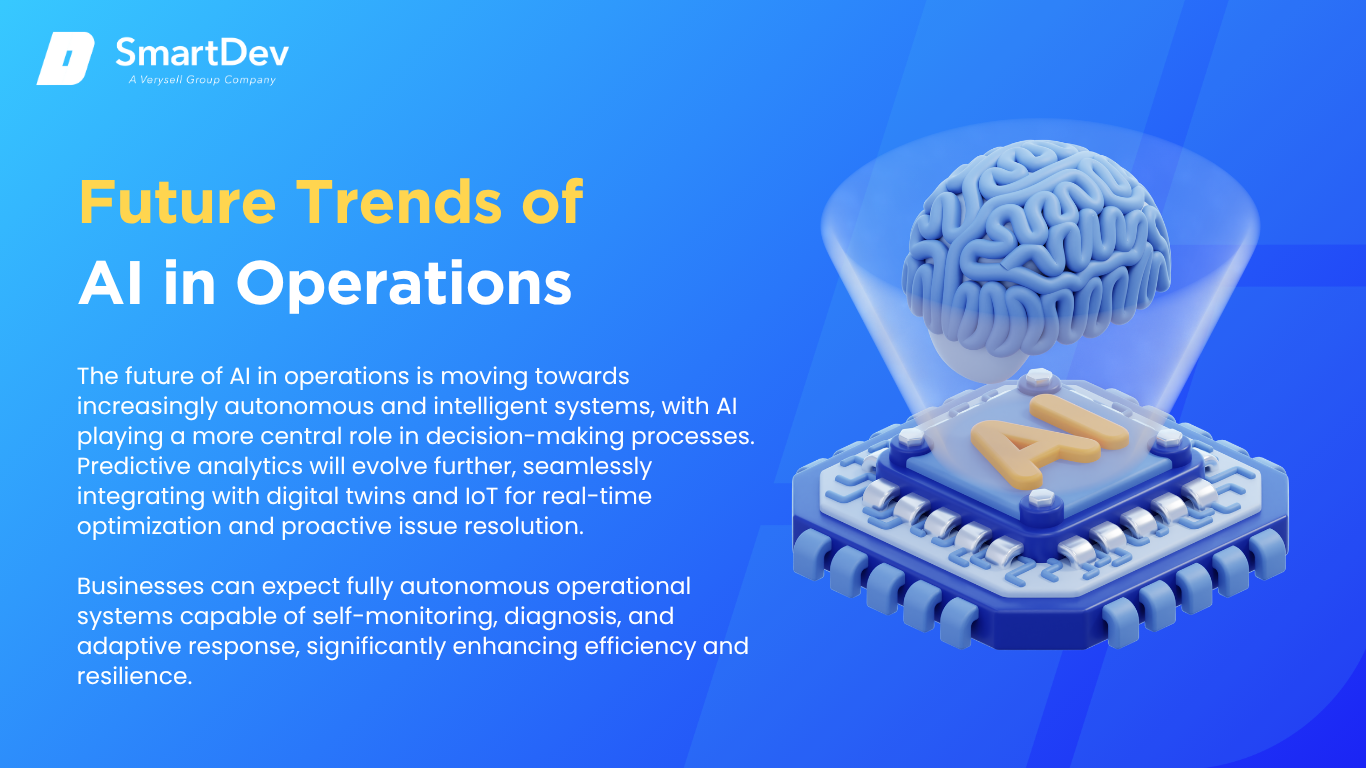
1. Predictions for the Next Decade
The future of AI in operations is moving towards increasingly autonomous and intelligent systems, with AI playing a more central role in decision-making processes. Predictive analytics will evolve further, seamlessly integrating with digital twins and IoT for real-time optimization and proactive issue resolution. Businesses can expect fully autonomous operational systems capable of self-monitoring, diagnosis, and adaptive response, significantly enhancing efficiency and resilience.
2. How Businesses Can Stay Ahead of the Curve
To stay competitive, businesses must adopt continuous innovation strategies, fostering agility and proactive integration of emerging AI technologies. Staying informed of industry advancements, investing in scalable infrastructure, and nurturing strategic partnerships with AI vendors and research institutions will be essential. Cultivating a culture of continuous learning and adaptation ensures that businesses can effectively leverage AI advancements to maintain operational leadership.
Conclusion
-
Summary of Key Takeaways on AI Use Cases in Pharma
AI is fundamentally transforming operational effectiveness across industries. Organizations successfully implementing AI report substantial gains in efficiency, cost savings, and sustainability. Businesses ready to adopt AI must strategically prepare their teams, data infrastructures, and workflows. Embracing AI today positions companies as leaders, equipped to leverage future innovations and sustain competitive advantage.
-
Call-to-Action for Businesses Considering AI Adoption
Businesses considering AI adoption should start with clear, focused initiatives, leveraging expert partnerships, and continuously measuring impact to refine and expand their AI strategies for long-term operational success.
References
- https://www.ibm.com/think/topics/ai-in-operations-management
- https://www.pwc.com/gx/en/services/consulting/digital-operations/ai-in-operations.html
- https://www.mckinsey.com/capabilities/operations/our-insights/generative-ai-in-operations
- https://www.enate.io/blog/4-ways-to-start-using-ai-in-operations-management-right-now-2024
- https://www.interesjournals.org/articles/the-impact-of-artificial-intelligence-on-operations-management.pdf
- https://www.techtarget.com/searchitoperations/definition/AIOps
- https://www.deloitte.com/nz/en/services/consulting/blogs/navigating-the-challenges-of-ai-in-operations-january-2025.html


